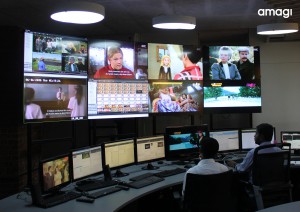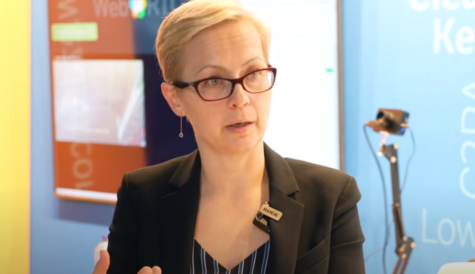
After more than 40 years of operation, DTVE is closing its doors and our website will no longer be updated daily. Thank you for all of your support.
Arriving on air: playout technology and multiplatform deployment
Multiplatform deployment, fast time to market and flexibility are becoming ever more important for channel providers. Is playout technology keeping up with the demands being made on it? Anna Tobin investigates.
In the old days of simple linear broadcasting, getting a TV channel on air was a huge financial, technological and logistical undertaking. While many aspects of the process are now simpler, the opportunities offered by anytime, anywhere instant content requirements have added a new dimension of trickiness, particularly to workflow and playout. Broadcasters are now publishers in charge of vast content management systems taking instantaneous orders, often from customers on the opposite side of the world.
The exponential growth in OTT and VoD in particular has put new demands on workflows in recent years. “In many cases, systems have evolved organically over time and have had to accommodate activities not originally envisioned in the design,” explains Steve Plunkett, CTO, broadcast and media services at Ericsson. “Business agility can be slowed down in such a situation as each additional requirement means long development and testing cycles. This has caused many organisations to re-architect and deploy newer technologies that allow systems to evolve more quickly and with greater flexibility.”
The state of a broadcaster’s existing digital supply chain and software-defined workflows is key to how prepared they are for new services, says Steve Smith, CTO of cloud at Imagine Communications. “Almost all broadcasters have transcode and media asset management capabilities, but it is less common for them to be integrated into a manufacture-to-order environment,” he explains. “When assets are manufactured to order through automated creation and delivery workflows, versus a human-driven push workflow or ‘hot folder’ system, delivery to new distribution platforms is straightforward and scalable. The effort is simply in defining the ‘what’ and ‘where’ of new distribution. Beyond that, there is the business aspect of planning content availability, scheduling and spot placement to drive revenue.”
In response to rapid change, playout and asset management is becoming increasingly automated and software-based. “The key thing to remember here is you can’t throw the baby out with the bath water, because the majority of the audience is still on traditional TV. Viewers are migrating. There is no denying that this is happening, but I don’t think traditional television will disappear anywhere soon either,” says Scott Rose, director of product management at Grass Valley.
Greater integration between channel providers and distribution platforms and outsourcing to service providers who can streamline workflow management is the answer to tackling new challenges, says Valéry Bonneau, media management product manager at Globecast.
“Many broadcasters are still struggling with separate content preparation silos for different target platforms and often trying to manage everything in house when they don’t have the economy of scale to do so. Service providers such as Globecast can invest once in on-boarding a delivery platform, or in understanding the regulatory compliance constraints of a country and leverage this across all of our customers. Our scale also enables us to provide elasticity in our workflows to allow us to accommodate last minute priority changes,” he says.
Lucrative localisation
As broadcasters become more global, content is in many ways becoming more localised.
“Since there are more platforms and distribution options, localisation and customisation of programming and advertising content has become a key differentiator for broadcasters needing to adhere to regional requirements,” says KA Srinivasan, co-founder of Amagi. “The bottleneck for broadcasters is shifting from last-mile distribution – i.e. lack of access to platforms or operators – to delivery capabilities for different platforms.”
Workflows need to be able to adapt to new markets agrees Alex Pannell, portfolio development director at Arqiva. “As channels move into more markets the workflows have to deal with a lot more complexity around subtitles and voiceovers, graphics and localisation of ads,” he says. “The workflows have to change and become a lot more complex, because they are dealing with more markets and, therefore, more complex requirements in terms of compliance. Different markets have different watershed times, for example. There is a lot more work to do around subtitles and voiceovers. Workflows have to become a more automated to deal with all this, as to deal with all this manually would be cost prohibitive.”
Taking your content further creates more financial opportunities and this is where localisation of advertising, subtitles and supplementary online content is key. Moving over to cloud-based content distribution is the best way of achieving this, says Srinivasan at Amagi. “It enables broadcasters to support regionalisation at a country level, along with the capability to monetise advertising in each country. The cloud-based approach also enables broadcasters to move away from a capex-based delivery model involving large onsite data centres, to one that is much more flexible and scalable,” he says.
It’s now possible to get a simple channel running recorded content up and running within hours. “If we have spare capability, for our existing customers we can get a new channel up and running in half a day,” says Pannell at Arqiva. “If we’re dealing with a new provider where you have to set up a new process for them to bring in their content, match it to schedules and you don’t have connectivity to where you want to distribute it, it can take you six to eight weeks.”
Often, however, there are basic obstacles, such as obtaining distribution and access to content to prevent channels launching, says Bonneau at Globecast. “For broadcasters that need rich branding, advanced navigation like dynamic now/next and later promotion, or integration of closed captions, subtitles or live content, more time will be needed to successfully manage the project.”
Channel launches are still costly and risky. Anyone that wants to have a channel up and running fast needs to understand how to build real-time synchronous broadcast systems using IT and IP technologies, says Plunkett at Ericsson. “This is not a trivial undertaking and one that can easily go wrong. The best advice today is to experiment and evaluate third-party solutions and note that real world implementations often behave differently to the trade show stand. Learn the characteristics and differences of the new technologies and look to partners who can help,” he says.
There is a lot of talk about the possibilities for quick-to-market pop-up channels, but while there has been some experimentation in this area, especially on the OTT side, surprisingly few have materialised.
“It looks like a market that should really work,” says Rose at Grass Valley, “but we don’t see a huge demand for pop-up TV yet. That might be to do with the fact that it’s more difficult to launch a pop-up channel if you’ve got to get on to a multiplex than if you’re going to deliver it as a stream to a device. As more viewers move to different methods of consumption, pop-up channels are likely to become more viable.”
Service providers who already have broadcast feeds and knowledge of event distribution are best placed to exploit this market when it develops.
On-demand
Viewing figures prove that time-shifted channels are still popular, but as consumers become more aware and confident about accessing on-demand content, these are likely to start losing their appeal. This will free up a lot of bandwidth. Satellite operators in particular would much rather their precious linear bandwidth wasn’t wasted on plus-one and plus-two channels.
For the time being however, content providers will need to juggle these services with the added complication of online delivery and integration with alternative distribution channels such as social networks and web video sites. The key to this, says Plunkett at Ericsson, is “high levels of automation, both in terms of media processing and platform operation. Doing this securely and with high resilience is not easy, but it can and is being done successfully.”
With most providers now running file-based content, it is a lot easier to create on-demand assets from live feeds too, either for streaming or as a VoD asset. The mass adoption of HTML5 has also made it much simpler to do this to multiple platforms and devices now. “The technology is there,” says Pannell at Arqiva, “but what tends to hold it up is editorial or platform standards – overlaying different graphics, putting bumpers at the start and end, for example.”
Pannell also says that on-demand feeds are often delayed for commercial reasons. “For some of our customers we can deliver VoD for them pretty much as soon as it’s gone out live, but what we find is that they often don’t want to do it too soon, because they feel that people won’t watch their linear schedule.”
Cloud technology is often seen as the future for playout, but there are very few who believe it is ready to cope with the demands of delivering live content. Its current strength lies in coordinating other aspects of playout. Globecast, for example, has developed a cloud-based customer portal to help with creating on-demand assets from live feeds. “This cloud-based tool allows our customers to work with us and other partners collaboratively on media preparation workflows,” says Bonneau. “They can see the status of all the content we hold for them, view the content and orchestrate tasks for third party specialist providers such as subtitling or dubbing.”
Jumping language barriers isn’t the only challenge in the on-demand space when broadcasters work internationally; regulations are another major hurdle to jump. Raul Aav, technical manager, play-out at Levira gives an example: “Levria is operating in a region where we are subjected to both Ofcom and Scandinavian regulations, when broadcasting the channels for our customers. Although some of the regulations are already covered during the programming stage by our customers, we have to be compliant with the technical ones – audio–video levels, de-flashing and compulsory localisation, etc.”
Investing in additional channels and services is one thing, but making that investment pay is another; and yet it seems that you need to be in it to win it.
“Making money is important, critical even, but a broadcaster in 2015, must have digital services available on multiple devices to retain an audience. Digital services are no longer just nice to have. If you don’t have them, your customers will leave,” says Bonneau. “How much money you make depends entirely on how smart you are with your business models and infrastructure. That is why we propose ‘pay as you grow’ solutions wherever possible. Those solutions include flexible playout with the ability to localise channels on the fly for different territories or platforms, multi-device OTT offers with integrated catch-up video management and a monetisation suite that enables broadcasters to maximise revenues with ad-funded, subscription or transactional payment models.”
Social media
As well as the demands of catch up and VoD, content providers are increasingly integrating their content with social media and web media sites too. This adds another dimension to requirements for QoE and security of content. To approach this pragmatically, broadcasters need to change their mindset, says Smith at Imagine Communications.
“Being under pressure is a good thing. It means there is demand for your product, but it [is] simply not being delivered quick enough or on the right platform. This is easy to fix,” he says. “The concept of ‘robust’ changes dramatically as you switch from broadcast to web. In a broadcast world the failure of any single device in the chain will impact a few thousand to a few million customers. In the web world, content is distributed or proxied by thousands of servers, so failure of any one impacts only a few customers and, in most cases, it will be invisible to the customer. Moving to IP-enabled platforms we get almost all the environmental robustness we are accustom to for free. It is just achieved differently.”
Maximising QoE across multiple platforms is down to selecting the right service provider, says Levira’s Aav. “Quality of experience can be achieved by selecting a service provider who fully understands all distribution platforms and end user devices and is able to cater to all of them with the same quality that is expected from a linear TV channel. I like to believe that Levira has earned a place among those companies…as our portfolio includes more and more channels where alternative distribution channels are considered even more important than the primary linear channel,” he says. Aav says that security is often overlooked by service providers who rush to second-screen distribution, adding that the same principles should be applied to streaming as are applied to TV and theatrical content today. “As one of the early adopters and developers of HbbTV we have been looking closely into ways of securing streams in such a way that they are only usable for the intended end user. We have been successful in our endeavours and hope to see similar practices being applied to streams originating from other VoD portals and sites,” he says.
It’s still a minefield out there, but with the right support and technology behind them, content providers should be able to get their channels to market quickly and competently; and, it should only get easier.




